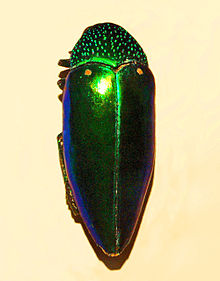
Buprestidae is a family of beetles known as jewel beetles or metallic wood-boring beetles because of their glossy iridescent colors. Larvae of this family are known as flatheaded borers. The family is among the largest of the beetles, with some 15,500 species known in 775 genera. In addition, almost 100 fossil species have been described.
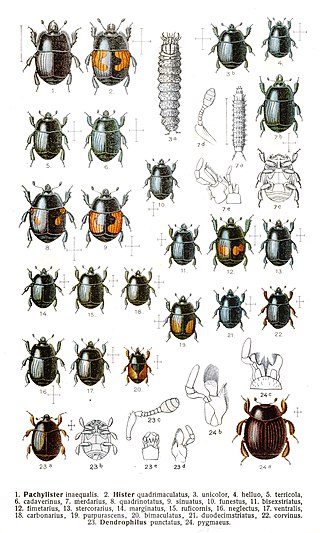
Histeridae is a family of beetles commonly known as clown beetles or hister beetles. This very diverse group of beetles contains 3,900 species found worldwide. They can be easily identified by their shortened elytra that leaves two of the seven tergites exposed, and their geniculate (elbowed) antennae with clubbed ends. These predatory feeders are most active at night and will fake death if they feel threatened. This family of beetles will occupy almost any kind of niche throughout the world. Hister beetles have proved useful during forensic investigations to help in time of death estimation. Also, certain species are used in the control of livestock pests that infest dung and to control houseflies. Because they are predacious and will even eat other hister beetles, they must be isolated when collected.

Dermestidae are a family of Coleoptera that are commonly referred to as skin beetles. Other common names include larder beetle, hide or leather beetles, carpet beetles, and khapra beetles. There are over 1,800 species described.
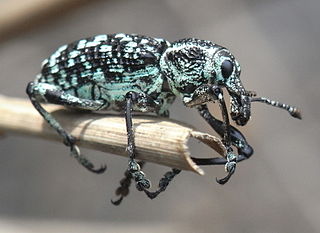
Chrysolopus spectabilis is a species of weevil found in south-eastern Australia. It was discovered during James Cook's first voyage, and became one of the first insects to be described from Australia. The weevil measures up to 25 mm (1.0 in) long and includes distinctive metallic green and black scales. It is found only on 28 species of the plant genus Acacia.

Actaeon beetle is a rhinoceros beetle of the family Scarabaeidae.

Beetlewing, or beetlewing art, is an ancient craft technique using iridescent beetle wings practiced traditionally in Thailand, Myanmar, India, China and Japan. Notable beetlewing garments include Lady Curzon's peacock dress (1903) and a costume dress worn by the actress Ellen Terry as Lady Macbeth, depicted in the painting Ellen Terry as Lady Macbeth (1889).

Lilioceris merdigera is a species of beetle belonging to the family Chrysomelidae, subfamily Criocerinae.

Lebia grandis is a ground beetle in the family Carabidae found in North America. It is a specialist predator on the eggs and larvae of Colorado potato beetles, and its larvae are obligate parasitoids of Colorado potato beetle pupae.
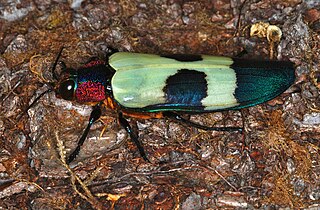
Chrysochroa buqueti, the red speckled jewel beetle, is a Southeast Asian species of beetle in the Buprestidae family and tribe Chrysochroini. It is found for example in Borneo and Malaysia.

Chrysochroa edwardsii is a beetle of the Buprestidae family.

Sternocera chrysis is a species of beetles belonging to the Buprestidae family. It has a dark reddish elytra and dark pronotum.

Sternocera sternicornis is a species of beetle belonging to the Buprestidae family.

The milkweed leaf beetle is a species of leaf beetle from the family Chrysomelidae. It is round bodied, 8–11 mm in length with a black head and pronotum and bright orange to yellow elytra with variable mottled black patches. It is colored and shaped like a super-sized ladybird beetle even though the ladybird is in a different family, Coccinellidae. The larva is shaped much like the adult except with a small tail extension. Its color varies from bright orange to white with a gray to black pronotum and prominent black spots around its spiracles.
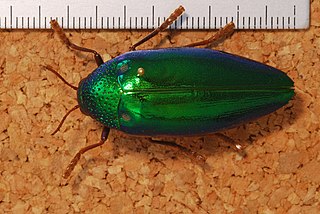
Sternocera ruficornis is a species of beetle belonging to the Buprestidae family. Its bright metallic green elytra are frequently used in jewellery making.
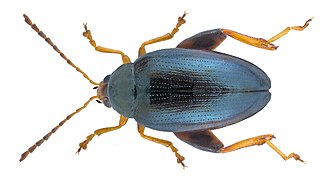
Psylliodes chrysocephala or Psylliodes chrysocephalus, commonly known as the cabbage-stem flea beetle, is a species of leaf beetle situated in the subfamily Galerucinae and the tribe Alticini.
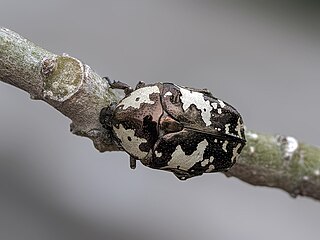
Protaetia aurichalcea is a species of flower-chafer beetle in the family Scarabaeidae. It is found in Asia.

Liatongus rhadamistus, or Scaptodera rhadamistus, is a species of dung beetle found in India, Sri Lanka, Laos and Thailand.
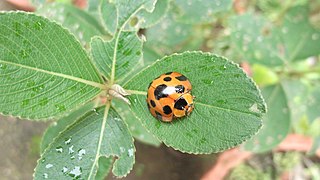
Synonycha grandis, commonly known as Giant bamboo ladybird, is a species of lady beetle found in Australia, Oceania and Southern Asia.
Platypria (Platypria) hystrix, is a species of leaf beetle found in India, China, Indonesia, Myanmar, Nepal, Sri Lanka, Thailand and Vietnam.

Cosmodela batesi is a species of tiger beetle endemic to Taiwan. Its English common name is Bates' Tiger Beetle. Its Chinese common name, 八星虎甲, translates to "Eight Star Tiger Beetle."
